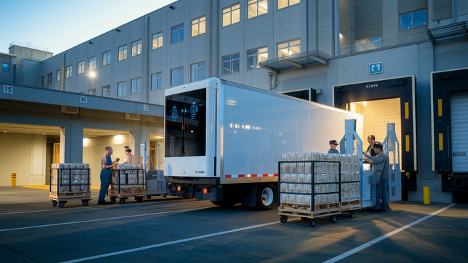
Cold Chain Logistics: Revolutionizing Food Distribution in Corrections
05/22/2025
Welcome to part two of our four-part series exploring innovations transforming how nutrition providers serve the Corrections industry. From sustainability and technology to nutrition and logistics, each installment dives into key trends shaping the future of institutional food programs.
We’re focusing on four key innovations that are reshaping correctional food systems across the country:
- Farm-to-Prison Programs: Enhancing Inmate Nutrition and Skills
- Cold Chain Logistics: Revolutionizing Food Distribution
- Innovative Supply Chain Strategies for Resilience
- Emerging Technologies in Food Safety and Traceability
This edition focuses on how cold chain logistics enables correctional facilities to deliver safer, fresher, and more efficient food service, unlocking new possibilities in compliance and nutrition.
The Role of Cold Chain Logistics in Correctional Food Service
Cold chain logistics refers to a temperature-controlled supply chain that keeps perishable foods within safe ranges—typically under 40°F (4.4°C)—from sourcing to consumption. In correctional facilities, where mass meal prep and delivery is a daily operation, an effective cold chain is critical for both food safety and efficiency.
The FDA notes that improper refrigeration is one of the leading causes of foodborne illness. With hundreds or even thousands of meals prepared daily in prisons, reliable cold storage is essential to ensure compliance with health standards and to avoid costly spoilage.
Smart Refrigeration Technology Enhances Food Safety
Today’s cold chain solutions use IoT-enabled temperature sensors, RFID tags, and real-time tracking software to keep food safe across all touchpoints. Providers like Thermo King and Carrier Transicold offer vehicle- and facility-based refrigeration monitoring that instantly alerts staff if food temperatures rise above safe thresholds.
Within correctional kitchens, tablet-based apps and smart refrigerators allow foodservice teams to monitor shelf life, rotate inventory, and avoid violations of USDA temperature safety guidelines.

Improved Storage and Operational Efficiency
Cold chain systems don’t just maintain food quality—they streamline foodservice operations. Solutions like WISE WMS integrate seamlessly into correctional facility workflows to manage everything from receiving to internal transfers and kitchen prep.
Facilities can benefit from:
- Barcode and RFID tracking for real-time visibility
- Automated alerts for low stock or expiring items
- Optimized transfer between central kitchens and housing units
- Reduced shrinkage and spoilage across inventory cycles
This added control is crucial in institutions where serving 10,000+ meals per week is the norm and supply chain disruptions can impact nutrition delivery instantly.
Reducing Waste and Carbon Emissions
The EPA reports that food waste is a significant source of methane in U.S. landfills. Correctional institutions are large contributors due to their scale, but cold chain technology is helping reverse that.
Cold chain logistics reduces waste by:
- Accurately forecasting needs to prevent over-ordering
- Extending product shelf life through precision temperature control
- Enabling real-time inventory visibility across locations
- Reducing “emergency procurement” linked to spoilage or shortages
Many providers now use route optimization software to reduce food miles and fuel consumption. By integrating locally sourced products and reducing transportation time, facilities lower their environmental footprint while boosting food freshness.
Supporting Nutritional Quality and Menu Flexibility
Cold chain infrastructure also unlocks better nutrition and greater menu flexibility. With reliable refrigeration and tracking, correctional kitchens can safely store and serve:
- Fresh produce
- Lean proteins
- Dairy and whole grain products
- Special-diet and plant-based meals
This aligns with guidelines from the American Correctional Association, which emphasize healthy, nutritionally adequate food offerings that also consider medical, religious, and cultural dietary needs.
Cold chain systems also support farm-to-prison sourcing models that bring in fresh, local ingredients, enhancing nutrition and sustainability. See our breakdown on these initiatives in “4 Innovations Reshaping Corrections Food Supply.”
Cold chain logistics is no longer a luxury—it’s a foundational component of safe, efficient, and sustainable correctional food service. By embracing technology-forward cold storage, smart tracking, and sustainable routing practices, facilities can improve food quality, cut waste, and meet rising standards in nutrition and compliance.
Next in this series: We’ll explore innovative supply chain strategies for resilience, including how corrections food systems are preparing for supplier volatility, labor shortages, and sourcing challenges in a post-pandemic world.
